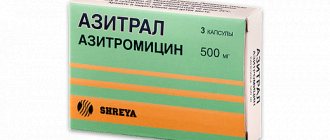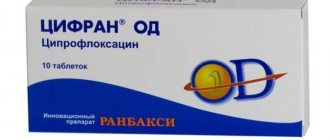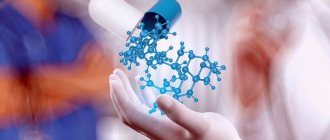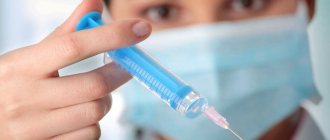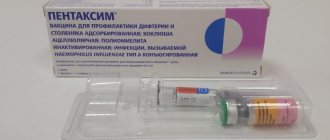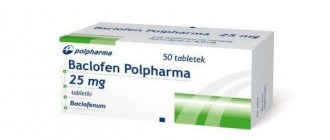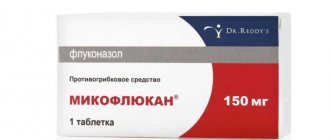2346
Author of the article
Evgeniy Nikolaevich Konoplev
Reading time: 9 minutes
AA
Mikosist is a broad-spectrum antimycotic intended for the etiotropic treatment of fungal infections. The drug is not suitable for all patients. That is why before taking it it is very important to make sure there are no contraindications by studying the instructions and consulting with your doctor.
Composition, release form and price
The only form of release of "Mikosist" is hard gelatin capsules with the contents in the form of a light powdery mass.
One such capsule contains 50 mg of the active substance, which is fluconazole. There are also excipients - lactose, colloidal silicon dioxide, corn starch, povidone K30, talc and magnesium stearate.
The price of one package containing 7 capsules is about 580 rubles.
By the way, many people are interested in whether “Mikosist” candles exist. So, the answer is: no. This medication is available only in capsule form. But this does not mean that Mikosist will not help against thrush, because there is an effect from taking the drug. If you are interested in suppositories, then in the pharmacy you can find “Fluconazole” in this release form with the same active ingredient.
Analogs
In the modern pharmaceutical market you can find many substitutes for Mikosist. Many of them not only have the chemical and pharmacological properties of the original, but are also cheaper. Thus, analogues of Mikosist in terms of the active component are:
- capsules Fangiflu, Vero-Fluconazole, Difluzol, Funzol, Flucoside, Flunon, Procanazole, Fluzol, Fluconorm and Ciskan;
- powder for preparing Diflucan suspension;
- solutions for infusion administration: Maiconil, Medoflucon, Diflazon, Flucosan, Flucomabol, Flucorus, Flucostat and Forkan;
- Mikoflucan and Fluconazole tablets;
- Mikomax syrup.
There are a number of drugs that do not contain fluconazole, but have an antifungal effect similar to Miconazole (in spectrum, strength, etc.). These include:
- capsules Irunin, Orungal, Rumikoz, Itrazol, Orunit, Teknazol, Canditral, Orungamin and Miconihol, the active ingredient of which is itraconazole;
- Vfend lyophilisate and tablets made on the basis of voriconazole;
- Noxafil oral suspension containing micronized posaconazole.
It is important to remember that all these drugs have side effects, absolute and relative contraindications. They can be used as substitutes for Mikosist only after agreeing on a new treatment regimen with your doctor.
Impact on the body
Due to their active substance, Mikosist capsules have an effect on most microorganisms of the Candida species. Once inside, fluconazole exhibits its effect as an inhibitor of sterol synthesis in fungal cells. It does not affect the concentration of testosterone in men or steroids in women. In some cases, resistance to this substance may develop.
Fluconazole is well absorbed, its total bioavailability is more than 90%. This process is not affected in any way by food consumption.
The maximum concentration is reached 30-90 minutes after taking the capsule. After about 5 days, the ee indicator becomes stable. However, if the patient takes a loading dose on the first day, which is twice the usual dose, then a constant concentration of 90% can be achieved by the second day.
The active substance penetrates into all body fluids. But the highest concentration is achieved in sweat, dermis, epidermis and stratum corneum. If you take the drug for a long time (for example, for four months once a week), it will accumulate in the nails.
At medium concentrations, fluconazole can be detected in breast milk.
The substance does not form metabolites. The half-life is approximately 30 hours. This substance is excreted primarily (80%) by the kidneys. Thanks to the long half-life, it becomes possible to use the drug once for some diseases (once a day or even a week).
Pharmacological properties
Fluconazole blocks the fungal enzyme cytochrome P450. This substance is necessary for the fungus to synthesize ergosterol, a lipid that ensures the integrity and strength of the cell membranes of the fungus and their reconstruction during the reproduction of the infectious agent. Without ergosterol, the cell membrane becomes thin and permeable to various ions. A change in the pressure level in the cell leads to damage to the membrane - in other words, the formation of holes. Through them, the contents of the cell come out, and the cell itself is broken down by the immune cells of the human body.
Mikosist contains lactose - this must be taken into account if you are intolerant to this substance
Some reactions in the body of mammals occur under the influence of the same enzyme. The advantage of fluconazole over other antifungal drugs is its selective effect on the fungal enzyme. This results in improved tolerability of the drug and a reduced risk of damaging the liver. Unlike other antimycotics (ketoconazole and isoconazole), fluconazole does not change the synthesis of certain hormones and does not affect the amount of testosterone and estrogens in the male or female body. Even with prolonged use of high doses of the drug, minor hormonal fluctuations occur.
Only 10% of the dose is bound to blood proteins. The substance is almost completely (about 90% of the dose) excreted unchanged. Excretion occurs through the kidneys.
After swallowing the capsules, maximum concentrations of fluconazole in the blood plasma are detected after 30-90 minutes. Stable, anti-fungal active amounts last for about 24 hours. Similar doses of the drug are detected in all biological fluids of the body (saliva, sputum). In the cerebrospinal fluid the concentration is 80% of the plasma concentration. The substance accumulates in tissues rich in keratin (all layers of skin, nails), and is excreted along with sweat and sebaceous secretions of the skin. Here the amount of fluconazole significantly exceeds plasma levels.
Indications
The instructions for use of "Mikosist" list the conditions for which a doctor may prescribe this drug:
- Invasive candidiasis.
- Coccidioidomycosis.
- Meningitis of the cryptococcal type.
- Candidiasis affecting the mucous membranes. Including pathologies of chronic mucocutaneous and oropharyngeal types, as well as candiduria and pathology of the esophagus.
- Dermatomycoses. Including dermatophytosis of the trunk, feet, groin, skin and lichen versicolor.
- Atrophic candidiasis of the chronic type, affecting the oral cavity. Associated, as a rule, with wearing dentures. In this case, local treatment and hygiene are not enough.
- Dermatophytosis of the nails.
Also, Mikosist tablets (or rather, capsules) are often prescribed to prevent the following ailments:
- Vaginal candidiasis.
- Cryptococcal meningitis in patients at high risk of relapse.
- Oropharyngeal candidiasis.
- Infections in people with prolonged neutropenia. As a rule, we are talking about people with hematological malignancies who are undergoing chemotherapy or hematopoietic stem cell transplantation.
- Esophageal candidiasis in HIV-infected patients.
However, no matter what is written in the instructions for use of Mikosist, only a doctor can prescribe such a serious drug to a person after conducting an examination and studying the tests. For it may be that the causative agent of his illness will be a microorganism against which fluconazole will be powerless.
Contraindications
The drug has a whole range of relative and absolute contraindications. According to the instructions for use, Mikosist is not prescribed to women during breastfeeding. In addition, reasons for refusing to use these capsules may be:
- simultaneous use of medications incompatible with fluconazole;
- pathological addiction to alcohol (including low-alcohol drinks);
- malabsorption of glucose-galactose;
- individual lactose intolerance;
- allergy to fluconazole, other components of the drug or azole compounds similar in structure to them;
- lack of lactase in the body;
- electrolyte imbalance;
- the appearance of a rash on the skin of patients who have previously been diagnosed with systemic invasive or superficial fungal infections;
- renal or liver failure;
- organic heart diseases;
- intolerance to acetylsalicylic acid.
Pregnant women are prescribed Mikosist only when the benefits of this medicine significantly outweigh the harm that can be caused to the fetus.
About the reception features
Mikosist tablets must be swallowed whole. If the doctor approves, the patient can begin therapy even before receiving laboratory test results.
However, when they become known, antifungal therapy may need to be changed. There will be no need to change the daily dose, even if the person is switched from IV to oral administration.
The amount in which the patient will need to take Mycosist depends on the severity and nature of the infection. The same can be said about the duration of the course: therapy continues until the laboratory and clinical signs of the disease disappear.
People with recurrent oropharyngeal candidiasis, cryptococcal meningitis, or AIDS are usually given additional supportive treatment to help prevent recurrence of the infection.
Whether you take Mikosist before or after a meal is not important.
Dosage for adults
The instructions for use of Mikosyst state in what quantities this drug should be taken, but the doctor always gives precise instructions.
General recommendations are:
- Cryptococcal infections: 400 mg on the first day, then 200-400 mg once a day. The duration of therapy depends on the mycological and clinical effect. But the treatment will last at least 6-8 weeks.
- Prevention of cryptococcal meningitis: 200 mg/day for as long as indicated by the doctor.
- Candidemia and other invasive infections: 800 mg on the first day, and then 400 mg/day. The recommended duration of treatment is two weeks after receiving the first negative test result and complete disappearance of symptoms.
- Coccidioidomycosis: 200-400 mg/day. Treatment can last 11-24 months. For histoplasmosis – 3-17 months. For sporotrichosis and paracoccidioidomycosis – 1-16 and 2-17 months, respectively.
- Infections affecting the meninges: 800 mg/day. In this case, treatment can last for a very long time - up to two years.
- If a life-threatening infection is diagnosed, the daily dose is increased to 800 mg.
Mikosist
Active substance:
Fluconazole*
Pharmgroup:
Antifungal agents
Average price in pharmacies
| Name | Manufacturer | average price |
| Mikosist 0.15 n1 caps | GEDEON RICHTER | 283.00 |
| Mikosist 0.15 n2 caps | GEDEON RICHTER | 536.00 |
| Mikosist 0.15 n4 caps | GEDEON RICHTER | 675.00 |
Analogs for the active substance:Vero-Fluconazole Disorel-Sanovel Diflazon Diflucan Maiconil Medoflucon Mikomax Mycoflucan Nofung Procanazole Fangiflu Flucosan Flucoside Flucomabol Flucomicide SEDICO Fluconazole Fluconazole Hexal Fluconazole STADA Fluconazole-LEKSVM Fluconazole-Teva Fluconorm Flucoral Flucorem Flucostat Forkan Fungolon Tsiskan | Application area:Vaginal candidiasis Dory's disease Vaginal candidiasis Rose Lovers Disease Schenck-Berman disease Visceral candidiasis Vulval candidiasis Vulvovaginal candidiasis Vulvovaginal candidiasis Vulvovaginitis candidiasis Vulvovaginitis mycotic Generalized candidiasis Generalized candidiasis Genital candidiasis Homograft Fungal paronychia Fungal eczema Fungal vaginitis Fungal dermatoses Fungal diseases of smooth skin Fungal diseases of smooth skin Fungal diseases of the larynx Fungal skin diseases Fungal diseases of the oral cavity Fungal infections of the mouth Fungal infectious and inflammatory diseases of the oral cavity Fungal infections of smooth skin Fungal infections of smooth body skin Fungal infections of smooth body skin Fungal infections of the conjunctiva Fungal nail infections Fungal infections of the cornea Foot fungus Dermatomycosis Ringworm in large skin folds Dermatomycosis of smooth skin Dermatomycosis of the legs Dermatomycoses Dermatomycosis of smooth skin Dermatophytosis of the genitals Dermatophytosis of the feet Disseminated candidiasis Yeast skin infection Isotransplantation Invasive candidiasis California fever Candidemia Vaginal candidiasis Candidiasis of internal organs Candidiasis of internal organs Candidiasis of internal organs Candidiasis of internal organs Generalized candidiasis Laryngeal candidiasis Candidiasis of the gastrointestinal tract Candidiasis of the gastrointestinal tract Intestinal candidiasis Skin candidiasis Candidiasis of the skin and mucous membranes Candidiasis of the skin and mucous membranes of the mouth and pharynx Candidiasis of the skin and mucous membranes of the mouth and pharynx Candidiasis of the skin of the nail folds Genitourinary candidiasis Genitourinary candidiasis Candidiasis of the genitourinary organs in women Candidiasis of the nail folds Nail candidiasis Perianal candidiasis Candidiasis of the esophagus Oral candidiasis Candidiasis of the rectum and lower intestine Oral candidiasis Candidiasis with damage to the skin and mucous membranes Candidiasis with damage to the skin and mucous membranes Candidiasis with damage to the skin and mucous membranes Systemic candidiasis Candidiasis of the oral mucosa Candidiasis of mucous membranes and skin Candidiasis of the mucous membranes Candidiasis of the mucous membranes Candidiasis of the mucous membranes Candidiasis of the mucous membranes Candidiasis of mucous membranes and skin Candidiasis of mucous membranes and skin Candidiasis of mucous membranes and skin Candidiasis of the mucous membranes of the esophagus Candidiasis of the mucous membranes of the oral cavity and pharynx Candidiasis of the oral cavity and pharynx Candidiasis due to Candida albicans Candidal paronychia Candidal balanitis Candidiasis balanoposthitis Candidal vaginitis Candidiasis vulvitis Vulvovaginal candidiasis Candidomycosis Candidomycosis of the skin Candidomycosis of mucous membranes Candiduria Mucocutaneous candidiasis of the oral cavity Skin candida infections Cutaneous candidiasis Coccidiodomycosis Coccidioidosis Coccidioidosis (coccidioidomycosis) Coccidioidomycosis Colpitis of fungal etiology Cryptococcal infection in patients with AIDS Cryptococcal meningitis Cryptococcal meningitis Cryptococcosis in patients with AIDS Treatment with mercaptopurine Pityriasis versicolor Pityriasis furfuracea (pityriasis furfuracea) |
Therapy for mucosal candidiasis
This case deserves special attention. Here's what patients should know about when to take the drug and dosage:
- Chronic mucocutaneous candidiasis: 50-100 mg/day for 28 days.
- Candiduria: 200-400 mg per day, which should be taken for 1-3 weeks. If a severe dysfunction of the immune system is diagnosed, the doctor will extend the treatment.
- Esophageal candidiasis: 200-400 mg on the first day, and then 100-200 mg. Therapy lasts from 14 to 30 days until remission is achieved.
- Oropharyngeal candidiasis: 200-400 mg on the first day, and then 100-200 mg daily for 1-3 weeks.
- Acute vaginal candidiasis, as well as candidal balanitis: once in an amount of 150 mg. If the doctor considers it necessary, he will prescribe 150 mg every three days. And then - maintenance treatment at a dose of 150 mg once a week.
- Atrophic candidiasis of the oral cavity: 50 mg once a day for two weeks, be sure to combine them with local antiseptics.
- Prevention of relapse of oropharyngeal candidiasis in people with HIV: either three times a week, 200 mg, or 100-200 mg per day. The duration of therapy is indefinite. The same applies to cases when it is necessary to prevent intestinal candidiasis in HIV patients.
Treatment of dermatomycosis
In this case, Mikosist (fluconazole) should be taken according to the following regimen:
- Tinea versicolor: 300-400 mg once a week. The course lasts from 7 to 21 days. You can opt for an alternative option - 50 mg once a day for 2-4 weeks.
- Dermatophytosis of the feet, skin, trunk, groin, and other candidal infections: 150 mg once a week or 50 mg per day. In any case, the duration of therapy is approximately 2-4 weeks. For mycosis of the feet, treatment can last up to 6 weeks.
- Onychomycosis: 150 mg once a week. Therapy lasts until the infected nail is completely replaced by a new, healthy one. As a rule, this takes from 3 months to one year. Depends on the patient’s age and nail growth rate.
- Prevention of candidiasis in people suffering from malignant neoplasms: 200-400 mg once a day. If the risk of developing a generalized infection is high, the dose is 400 mg.
Also, Mikosist should be taken several days before the expected development of neutropenia, as well as another week after the number of neutrophils exceeds 1000/mm3.
Instructions:
Clinical and pharmacological group
09.001 (Antifungal drug)
Release form, composition and packaging
◊ Hard gelatin capsules, size No. 4 (Coni-Snap), with a light blue opaque cap (L 910) and a white opaque body (L 500); the contents of the capsules are white or almost white powder or a dense powdery mass.
| 1 caps. | |
| fluconazole | 50 mg |
Excipients: colloidal silicon dioxide 0.3 mg, magnesium stearate 1.2 mg, talc 3.3 mg, povidone K30 3.6 mg, corn starch 12.1 mg, anhydrous lactose 49.5 mg.
Composition of hard gelatin capsules: lower part - titanium dioxide (CI77891/E171) 2%, gelatin up to 100%; lower part: - indigo carmine (CI73015/E132) 0.0086%, titanium dioxide (CI77891/E171) 4%, gelatin up to 100%.
7 pcs. - blisters (1) - cardboard packs.
◊ Hard gelatin capsules, size No. 2 (Coni-Snap), with a turquoise opaque cap (L 890) and a white opaque body (L 500); the contents of the capsules are white or almost white powder or a dense powdery mass.
| 1 caps. | |
| fluconazole | 100 mg |
Excipients: colloidal silicon dioxide 0.6 mg, magnesium stearate 2.4 mg, talc 6.6 mg, povidone K30 7.2 mg, corn starch 24.2 mg, anhydrous lactose 99 mg.
Composition of hard gelatin capsules: lower part - titanium dioxide (CI77891/E171) 2%, gelatin up to 100%; upper part - indigo carmine (CI73015/E132) 0.0471 mg, titanium dioxide (CI77891/E171) 1%, gelatin up to 100%.
7 pcs. - blisters (4) - cardboard packs.
◊ Hard gelatin capsules, size No. 1 (Coni-Snap), with a blue opaque cap (54.038) and a white opaque body (L 500); the contents of the capsules are white or almost white powder or a dense powdery mass.
| 1 caps. | |
| fluconazole | 150 mg |
Excipients: colloidal silicon dioxide 0.9 mg, magnesium stearate 3.6 mg, talc 9.9 mg, povidone K30 10.8 mg, corn starch 36.3 mg, anhydrous lactose 148.5 mg.
Composition of hard gelatin capsules: lower part - titanium dioxide (CI77891/E171) 2%, gelatin up to 100%; upper part - indigo carmine (CI73015/E132) 0.2513%, titanium dioxide (CI77891/E171) 1.5%, gelatin up to 100%.
1 PC. - blisters (1) - cardboard packs. 1 pc. - blisters (2) - cardboard packs.
The solution for infusion is colorless or slightly colored, transparent.
| 1 ml | 1 fl. | |
| fluconazole | 2 mg | 200 mg |
Excipients: sodium chloride, water for injection.
100 ml - glass bottles (1) - cardboard packs.
pharmachologic effect
Antifungal drug. Fluconazole, a member of the triazole antifungal class, is a powerful selective inhibitor of sterol synthesis in fungal cells.
Active against pathogens of opportunistic mycoses, incl. caused by Candida spp., Cryptococcus neoformans, Microsporum spp., Trichophyton spp. Fluconazole has also been shown to be active in models of endemic mycoses, including infections caused by Blastomyces dermatitidis, Coccidioides immitis and Histoplasma capsulatum.
Pharmacokinetics
The pharmacokinetic parameters of fluconazole are similar when administered intravenously and orally.
Suction
After oral administration, fluconazole is well absorbed. Bioavailability is 90%. After taking the drug orally on an empty stomach at a dose of 150 mg, Cmax is 90% of the plasma content with intravenous administration of the drug at a dose of 2.5-3.5 mg/l. Concomitant food intake does not affect oral absorption. Cmax is achieved 0.5-1.5 hours after taking fluconazole. Plasma concentration is directly proportional to the dose taken.
Distribution
90% Css is achieved by 4-5 days of treatment with the drug (when taken once a day).
Administration of a loading dose (on the 1st day), 2 times higher than the average daily dose, allows you to achieve a 90% Css level by the 2nd day. The apparent Vd approaches the total water content of the body. Protein binding - 11-12%.
Fluconazole penetrates well into all body fluids. Concentrations of fluconazole in saliva and sputum are similar to plasma concentrations. In patients with fungal meningitis, fluconazole levels in the cerebrospinal fluid are approximately 80% of plasma levels.
In the stratum corneum, epidermis, dermis and sweat fluid, high concentrations are reached that exceed serum concentrations.
Removal
T1/2 is about 30 hours. Fluconazole is excreted mainly by the kidneys; approximately 80% of the administered dose is found unchanged in the urine. Fluconazole clearance is proportional to QC. Fluconazole metabolites were not detected in the blood.
Dosage
For adults with cryptococcal meningitis and cryptococcal infections of other localization, 400 mg is prescribed on the first day, and then treatment is continued at a dose of 200-400 mg 1 time / day. The duration of treatment for cryptococcal infections depends on clinical effectiveness confirmed by mycological research; for cryptococcal meningitis, therapy is usually continued for at least 6-8 weeks.
To prevent recurrence of cryptococcal meningitis in AIDS patients, after completion of the full course of primary treatment, fluconazole therapy at a dose of 200 mg/day can be continued for a very long period.
For candidemia, disseminated candidiasis and other invasive candidal infections, the dose is on average 400 mg on the first day, and then 200 mg/day. If clinical effectiveness is insufficient, the dose may be increased to 400 mg/day. The duration of therapy depends on clinical effectiveness.
For oropharyngeal candidiasis, the drug is prescribed on average 50-100 mg 1 time/day; Duration of therapy is 7-14 days. If necessary, in patients with a pronounced decrease in immunity, treatment may be longer.
For atrophic candidiasis of the oral cavity associated with wearing dentures, the drug is prescribed at an average dose of 50 mg 1 time / day for 14 days in combination with local antiseptics for treating the denture.
For other candidiasis infections of the mucous membranes (with the exception of genital candidiasis), for example, esophagitis, non-invasive bronchopulmonary lesions, candiduria, candidiasis of the skin and mucous membranes, the effective dose averages 50-100 mg/day with a treatment duration of 14-30 days.
To prevent relapses of oropharyngeal candidiasis in patients with AIDS after completing the full course of primary therapy, fluconazole can be prescribed 150 mg once a week.
For vaginal candidiasis, fluconazole is taken orally once at a dose of 150 mg. To reduce the frequency of relapses of vaginal candidiasis, the drug can be used at a dose of 150 mg 1 time/month. The duration of therapy is determined individually; it varies from 4 to 12 months. Some patients may require more frequent use.
For balanitis caused by Candida, fluconazole is prescribed as a single dose of 150 mg orally.
For the prevention of candidiasis, the recommended dose of fluconazole is 50-400 mg 1 time / day, depending on the degree of risk of developing a fungal infection. If there is a high risk of generalized infection, for example in patients with expected severe or long-lasting neutropenia, the recommended dose is 400 mg 1 time / day. Fluconazole is prescribed several days before the expected onset of neutropenia; after the number of neutrophils increases to more than 1000/μl, treatment is continued for another 7 days.
For mycoses of the skin, including mycoses of the feet, smooth skin, groin area and skin candidiasis, the recommended dose is 150 mg 1 time/week or 50 mg 1 time/day. The duration of therapy in normal cases is 2-4 weeks, however, with mycoses of the feet, longer therapy may be required (up to 6 weeks).
For pityriasis versicolor, the recommended dose is 300 mg once a week. within 2 weeks; some patients require a third dose of 300 mg/week, while in some cases a single dose of 300-400 mg is sufficient. An alternative treatment regimen is the use of the drug 50 mg 1 time / day for 2-4 weeks.
For onychomycosis, the recommended dose is 150 mg once a week. Treatment should be continued until the infected nail is replaced (the uninfected nail regrows). It normally takes 3-6 months and 6-12 months for fingernails and toenails to re-grow, respectively.
For deep endemic mycoses, it may be necessary to use the drug at a dose of 200-400 mg/day for up to 2 years. The duration of therapy is determined individually; it is 11-24 months for coccidioidomycosis, 2-17 months for paracoccidioidomycosis, 1-16 months for sporotrichosis and 3-17 months for histoplasmosis.
In children, as with similar infections in adults, the duration of treatment depends on the clinical and mycological effect. In children, the drug should not be used in a daily dose higher than that in adults. The drug is used daily 1 time/day.
For the treatment of generalized candidiasis and cryptococcal infection, the recommended dose is 6-12 mg/kg/day, depending on the severity of the disease.
For the prevention of fungal infections in children with reduced immunity, in whom the risk of developing infection is associated with neutropenia developing as a result of cytotoxic chemotherapy or radiation therapy, the drug is prescribed at a dose of 3-12 mg/kg/day, depending on the severity and duration of persistence of induced neutropenia.
For candidiasis of the mucous membranes, the recommended dose of fluconazole is 3 mg/kg/day. On the first day, a loading dose of 6 mg/kg may be prescribed in order to more quickly achieve constant equilibrium concentrations.
When prescribing a d/infusion solution to newborns, it should be taken into account that fluconazole is excreted more slowly, therefore, in the first 2 weeks of life, the drug is prescribed at the same dose (calculated in mg/kg body weight) as for older children, but with an interval of 72 hours For children aged 3 and 4 weeks of life, the same dose is administered at intervals of 48 hours.
In children with impaired renal function, the daily dose of the drug should be reduced (in the same proportion as in adults) in accordance with the severity of renal failure.
In elderly patients in the absence of signs of renal failure, the usual dosage regimen should be followed.
Patients with renal failure (creatinine clearance <50 ml/min) require dosage adjustment.
Fluconazole is excreted mainly in the urine unchanged. When taken once, no dose change is required. When re-prescribed to patients with impaired renal function, a loading dose of 50 mg to 400 mg should be administered.
When CC>50 ml/min, the average recommended dose of the drug is used; with CC from 11 to 50 ml/min, a dose of 50% of the recommended dose is used. For patients regularly undergoing hemodialysis, one dose of the drug is administered after each hemodialysis session.
Rules for administering the solution for infusion
Fluconazole in the form of a solution for infusion is administered intravenously at a rate of no more than 20 mg (10 ml) per minute. When switching from intravenous administration to capsules and vice versa, there is no need to change the daily dose of the drug.
The infusion solution is compatible with the following solutions: 20% dextrose (glucose) solution, Ringer's solution, Hartmann's solution, potassium chloride solution in dextrose, sodium bicarbonate solution 4.2%, 0.9% sodium chloride solution.
Fluconazole infusions can be given using conventional transfusion sets using one of the fluids listed above.
Overdose
Symptoms: hallucinations, paranoid behavior.
Treatment: gastric lavage and symptomatic therapy are recommended. Since fluconazole is excreted in the urine, forced diuresis increases its excretion. Hemodialysis for 3 hours reduces the concentration of fluconazole in plasma by 50%.
Drug interactions
When fluconazole was used with warfarin, an increase in prothrombin time by 12% was observed. In this regard, it is recommended to monitor prothrombin time in patients receiving Mikosist® in combination with coumarin anticoagulants.
With simultaneous use, fluconazole increases T1/2 of oral hypoglycemic drugs - sulfonylurea derivatives (chlorpropamide, glibenclamide, glipizide and tolbutamide) in healthy volunteers. Co-administration of fluconazole and oral hypoglycemic drugs is allowed, but the possibility of developing hypoglycemia should be taken into account.
Concomitant use of fluconazole and phenytoin may be accompanied by an increase in phenytoin concentrations to a clinically significant extent. If concomitant use of two drugs is required, phenytoin levels should be monitored and the dose adjusted to ensure therapeutic serum concentrations.
The simultaneous use of fluconazole and rifampicin leads to a decrease in AUC by 25% and a shortening of T1/2 of fluconazole by 20%. In patients receiving concomitant rifampicin, it is necessary to consider the advisability of increasing the dose of fluconazole.
It is recommended to monitor the concentration of cyclosporine in the blood in patients receiving fluconazole, because When using fluconazole and cyclosporine in patients with a kidney transplant, taking fluconazole at a dose of 200 mg/day slowly increased the concentration of cyclosporine.
Patients receiving high doses of theophylline, or who are at risk of developing theophylline toxicity, should be monitored for early detection of symptoms of theophylline overdose, as simultaneous administration of fluconazole leads to a decrease in the average rate of clearance of theophylline from plasma.
With the simultaneous use of fluconazole and cisapride, cases of adverse reactions from the heart, including paroxysms of ventricular tachycardia (AR), have been described.
There are reports of interaction between fluconazole and rifabutin, accompanied by an increase in serum levels of the latter. With the simultaneous use of fluconazole and rifabutin, cases of uveitis have been described. Patients receiving rifabutin and fluconazole simultaneously should be carefully monitored.
With the simultaneous use of zidovudine and fluconazole, an increase in the concentration of zidovudine in plasma is observed, which is caused by a decrease in the conversion of the latter into the main metabolite, so an increase in adverse reactions should be expected.
Use during pregnancy and lactation
The use of Mikosist® during pregnancy is not advisable, with the exception of severe or life-threatening forms of fungal infections, if the expected benefit to the mother outweighs the possible risk to the fetus.
Fluconazole is found in breast milk in the same concentration as in plasma, so its use during lactation is not recommended.
Side effects
From the digestive system: nausea, vomiting, flatulence, abdominal pain, diarrhea; rarely - liver dysfunction (hyperbilirubinemia, increased activity of liver enzymes /ALT, AST, alkaline phosphatase).
From the central nervous system: headache; rarely - convulsions.
From the hematopoietic system: rarely - leukopenia, thrombocytopenia, neutropenia, agranulocytosis.
Allergic reactions: skin rash; rarely - malignant exudative erythema (Stevens-Johnson syndrome), toxic epidermal necrolysis (Lyell's syndrome), anaphylactoid reactions.
Other: rarely - renal dysfunction, alopecia, hypercholesterolemia, hypertriglyceridemia, hypokalemia.
Storage conditions and periods
The drug should be stored at a temperature of 15° to 30°C. The shelf life of capsules is 5 years, solution for infusion is 2 years.
Indications
— cryptococcosis, including cryptococcal meningitis and other localizations of this infection (including lungs, skin), both in patients with a normal immune response and in patients with various forms of immunosuppression (including in patients with AIDS, with organ transplantation ); the drug can be used to prevent cryptococcal infection in AIDS patients;
- generalized candidiasis, including candidemia, disseminated candidiasis and other forms of invasive candidiasis (including infections of the peritoneum, endocardium, eyes, respiratory and urinary tract). Treatment can be carried out in patients with malignant neoplasms, patients in intensive care units, patients receiving cytotoxic or immunosuppressive drugs, as well as in the presence of other factors predisposing to the development of candidiasis;
— candidiasis of the mucous membranes, incl. oral cavity and pharynx (including atrophic candidiasis of the oral cavity associated with wearing dentures), esophagus, non-invasive bronchopulmonary infections, candiduria, skin candidiasis; prevention of relapse of oropharyngeal candidiasis in patients with AIDS;
- genital candidiasis: vaginal candidiasis (acute and chronic recurrent), prophylactic use to reduce the frequency of relapses of vaginal candidiasis (3 or more episodes per year); candidal balanitis;
- prevention of fungal infections in patients with malignant neoplasms who are predisposed to such infections as a result of cytotoxic chemotherapy or radiation therapy;
— mycoses of the skin, including mycoses of the feet, body, groin area, pityriasis versicolor, onychomycosis and skin candidiasis;
- deep endemic mycoses, coccidioidomycosis, paracoccidioidomycosis, sporotrichosis and histoplasmosis in patients with normal immunity.
Contraindications
- simultaneous use of terfenadine or astemizole and other drugs that prolong the QT interval;
- children up to 6 months of age (for oral administration);
- hypersensitivity to the drug or azole compounds similar in structure.
special instructions
In rare cases, the use of fluconazole was accompanied by toxic changes in the liver, incl. with a fatal outcome, mainly in patients with serious concomitant diseases. There was no obvious dependence of the incidence of hepatotoxic effects of fluconazole on the total daily dose, duration of therapy, gender and age of the patient. The hepatotoxic effect of fluconazole is usually reversible; its signs disappeared after cessation of therapy. If clinical signs of liver damage that may be associated with fluconazole appear, the drug should be discontinued.
People with AIDS are more likely to develop severe skin reactions when taking many drugs. If a patient receiving treatment for a superficial fungal infection develops a rash that can be associated with fluconazole, the drug should be discontinued. If a rash appears in patients with invasive/systemic fungal infections, they should be closely monitored and fluconazole should be discontinued if bullous lesions or erythema multiforme develop.
Caution must be exercised when using fluconazole simultaneously with cisapride, astemizole, rifabutin, tacrolimus or other drugs metabolized by isoenzymes of the cytochrome P450 system.
Use for renal impairment
Patients with renal failure (creatinine clearance <50 ml/min) require dosage adjustment.
Fluconazole is excreted mainly in the urine unchanged. When taken once, no dose change is required. When re-prescribed to patients with impaired renal function, a loading dose of 50 mg to 400 mg should be administered.
When CC>50 ml/min, the average recommended dose of the drug is used; with CC from 11 to 50 ml/min, a dose of 50% of the recommended dose is used. For patients regularly undergoing hemodialysis, one dose of the drug is administered after each hemodialysis session.
Use for liver dysfunction
In rare cases, the use of fluconazole was accompanied by toxic changes in the liver, incl. with a fatal outcome, mainly in patients with serious concomitant diseases. The hepatotoxic effect of fluconazole is usually reversible; its signs disappeared after cessation of therapy. If clinical signs of liver damage that may be associated with fluconazole appear, the drug should be discontinued.
Conditions for dispensing from pharmacies
The drug in capsule form is approved for use as an over-the-counter product.
The drug in the form of a solution for infusion is available with a prescription.
Use in patients under 18 years of age
In children and adolescents, as in adults, the duration of therapy depends on the mycological and clinical effect. However, the daily dose for them should not be greater than that established for adults. And you need to take the product once a day.
The drug is taken as follows:
- Candidiasis of the mucous membranes: 3 mg/kg 1 time/day. But on the first day you can use a loading dose calculated according to the formula 6 mg/kg.
- Cryptococcal meningitis and invasive candidiasis: 6-12 mg/kg/day.
- Suppression of relapse of cryptococcal meningitis in young patients suffering from AIDS: 6 mg/kg/day.
- Prevention of fungal infections in children and adolescents with poor immunity, as well as in those undergoing radiation or chemical therapy: 3-12 mg/kg/day.
If the child cannot be given capsules, the doctor may suggest intravenous fluconazole in doses equivalent to those listed.
Active substance
The active component of all formulations of Mikosist is the antifungal compound fluconazole. This is a synthetic substance that is effective against the most common fungi - representatives of the genus Candida. The substance-resistant strain is Candida krusei. The compound is also effective against other superficial mycoses caused by Microsporum spp., Trichophyton spp. Fluconazole-based drugs are used to treat deep and intraorgan fungal infections:
What to do if you have a fungus?!
Read more >> |
- histoplasmosis;
- blastomycosis;
- coccidioidosis;
- paracoccidioidosis.
Treatment of special patients
It happens that the medicine "Mikosist" is prescribed to elderly patients. If they do not have renal failure (with a creatinine clearance <50 ml/min), then the drug is taken in standard doses. Otherwise, adjustments are made. But not in the case when a single dose is indicated - only in the case of long-term therapy.
With repeated use of the drug, people with renal failure (including children) take a loading dose (from 50 to 400 mg) once, and then a daily, minimal dose. Ee, depending on the severity of the condition, the doctor can reduce it by half.
However, if a patient is undergoing regular dialysis, he should receive 100% of the recommended dose after each session. And when it is not carried out, the amount of the drug is reduced.
For children suffering from renal impairment, the dose is reduced in proportion to the adult dose, taking into account the severity of their disease.
Side effects
When using Mikosist, disorders of certain body systems may develop:
- Nervous system: dizziness, convulsions, headache;
- Digestive system: abdominal pain, diarrhea, flatulence, liver dysfunction (hepatocellular necrosis, including fatal, jaundice, hepatitis, hyperbilirubinemia, increased activity of alkaline phosphatase, hepatic transaminases), changes in taste, nausea, vomiting;
- Cardiovascular system: ventricular flutter and/or fibrillation, increase in the duration of the QT interval on the electrocardiogram;
- Metabolism: hypertriglyceridemia, hypokalemia, hypercholesterolemia;
- Hematopoietic organs: agranulocytosis, thrombocytopenia, neutropenia, leukopenia;
- Allergic reactions: erythema multiforme (including Stevens-Johnson syndrome), bronchial asthma (in most cases with intolerance to acetylsalicylic acid), anaphylactoid reactions (including facial swelling, skin itching, urticaria, angioedema), Lyell's syndrome, skin rash;
- Other: alopecia, functional kidney disorders.
Side effects and overdose
Mikosist is a serious drug, and undesirable reactions are possible. Although, as a rule, tolerability is very good. But most often you may encounter the following side effects:
- Headache.
- Increased serum aminotransferase activity.
- Discomfortable sensations in the abdomen.
- Rash.
There are also dozens of rare side effects - urticaria, leukopenia, anaphylaxis, ventricular tachycardia of the polymorphic type, an increase in the concentration of cholesterol in the blood, myalgia, etc. But, according to statistics, they almost never occur in anyone.
Drug interactions
When taking Mikosist for a course, it is very important to take into account its compatibility with other drugs. Thus, patients undergoing treatment with this medicine should remember the following:
- with simultaneous administration of sulfonylurea drugs, the risk of developing hypoglycemia significantly increases;
- rifampicin sharply reduces the concentration of fluconazole in the patient’s blood;
- the combined use of terfenadine leads to severe, life-threatening arrhythmias;
- with simultaneous administration of hydrochlorothiazide, the concentration of fluconazole in the blood plasma increases by 40%;
- synchronous use of cisapride can lead to the development of paroxysms of ventricular tachycardia and other adverse reactions from the cardiovascular system;
- fluconazole significantly increases the nephrotoxicity of tacrolimus;
- the combined administration of midazolam increases the likelihood of negative psychomotor reactions.
In addition, doctors recommend caution when using Mikosist and drugs based on phenytoin, theophylline, cyclosporine and zidovudine. Fluconazole can help increase the concentration of these compounds in the patient's blood to critical levels.
Reviews
People who have taken the drug "Mikosist" claim that it is a really effective remedy. And here is just a small part of the comments that can be found about this medication:
- Despite the fact that the product is not available in capsules, it helps to cope with thrush. Within a few days after starting to use the tablets, the burning and itching goes away, and the discharge also becomes less intense.
- Mikosist helps to cope with mucosal candidiasis in two weeks, while other popular drugs turn out to be useless.
- If the disease was identified immediately, the remedy helps alleviate unpleasant symptoms within a few hours after its use.
- The tablets help not only to recover, but also to normalize hormonal levels and achieve stable remission.
- There are practically no side effects. Only a small proportion of patients noticed discomfort in the abdominal area and unpleasant sensations when urinating, which disappeared after a few hours.
- After treatment, the condition of hair and skin improves.
- Some people claim that taking one capsule was enough for them to get rid of the disease. But others still recommend a course of treatment. It's more reliable.
And there are hundreds of positive reviews. Such feedback from satisfied patients is the best proof that the medicine is really worth the money. However, before starting drug therapy, you need to undergo an examination and pass all the necessary tests. Because self-medication, as a rule, does not end in anything good.
Pregnancy and lactation
Mikosist is prescribed to pregnant women in case of serious systemic and chronic fungal diseases. The drug can penetrate the placental barrier and disrupt the development of the child. However, if there is a threat to the life of the mother, an antifungal agent will be prescribed despite the possible risks to the fetus.
Fluconazole penetrates into all body fluids. Concentrations equal to plasma concentrations are determined in breast milk. The drug is not prescribed to nursing mothers. If treatment with Mycosist is necessary, the woman should stop breastfeeding.
